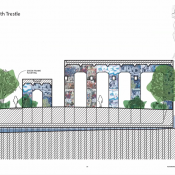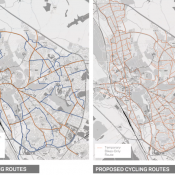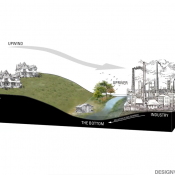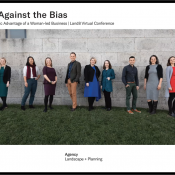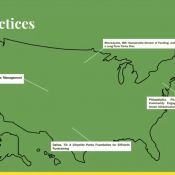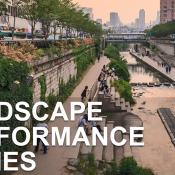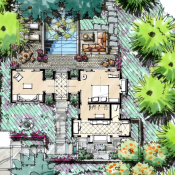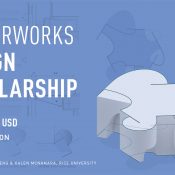Author: Land8: Landscape Architects Network
Sara Zewde | Recent Work [Webinar]
Description:
In the context of rapid urban development, a changing climate, and clarified social and political tensions, the narratives embedded in ecologies of memory offer creative departures for landscape architecture today. Sara Zewde will discuss the recent design work of Studio Zewde in this context.
This webinar is from the Land8 Virtual Conference sponsored by Anova Furnishings, recorded on April 23, 2020.
Brian Jencek | Healthy Cities: City-Making at the Intersection of Landscape Architecture and Public Health [Webinar]
Description:
Great cities are defined by their great streets and open spaces. Yet the very existence of cities continues to be challenged by pandemics and climate change. Join this session to learn how landscape architecture is redefining cities through the lens of human health and resilience.
This webinar is from the Land8 Virtual Conference sponsored by Anova Furnishings, recorded on April 23, 2020.
Designing High-Performing (Digital) Landscapes: Social Media’s Place in Landscape Architecture [Webinar]
Description:
Social media, when used correctly, is an invaluable tool to landscape architects. Social media plays a critical role in how landscape architects control the profession’s narrative in an architecture-focused media landscape.
Learning Outcomes:
- Attendees will learn how important a social media presence is, why it matters, and how it contributes overall to educating people about the profession
- Attendees will learn about the various social media platforms available for use and how to create a sound strategy
- Attendees will understand available social media metrics, how and when to report, and how these insights prove an ROI to leadership and board members
- Attendees will learn tips for crowdsourcing content from employees across their firm so everyone feels represented and increasing follower engagement
Presenters:
- Catherine Saunders, TBG Partners
- Emma Tardella, NAK Design Strategies
- Matt Alcide, Land8: Landscape Architecture Network
This webinar is from the Land8 Virtual Conference sponsored by Anova Furnishings, recorded on April 22, 2020.
Kurt Culbertson | Spatial Equity in the Time of Covid 19 [Webinar]
Description:
The imperative for designers to create spaces of great social interaction that bring together diverse, multi-generational populations is now being questioned in the midst of the COVID-19 pandemic. Yet out of this crisis and chaos can come lasting opportunities to rethink the nature of work, to redefine resiliency to address challenges of pandemics and other health crisis, and to examine the equitable design of public spaces which are flexible and adaptable to a new understanding of public health. The pandemic has been particularly devastating for seniors, low income communities, and people of color. In the face of our current challenges, we need to determine the place of landscape architects in crafting a safer, more equitable society.
This webinar is from the Land8 Virtual Conference sponsored by Anova Furnishings, recorded on April 22, 2020.
Gina Ford | Cutting Against the Bias – a Talk About the Strategic Advantage of Gender and Design [Webinar]
Description:
The conversation about gender in design practice often leans in on the challenges – that women are not achieving at the same rate as their male colleagues and that their achievements are not seen or celebrated in the same way. Agency – as a practice model rooted in an optimistic philosophy of the same name – claims being women-led as a strategic advantage. This presentation will discuss gender as a creative driver in practice, a multi-faceted benefit in business, and a critical dimension of diversity in design.
This webinar is from the Land8 Virtual Conference sponsored by Anova Furnishings, recorded on April 21, 2020.
John Surico | Revitalizing Urban Parks After COVID-19 [Webinar]
Description:
With half of the world now living under lockdown, the ability to go outside and get some fresh air has never been so important, or so fiercely contested. As those who can afford to do so converge on green spaces, seeking exercise and solace amid the coronavirus pandemic, parks have become stages for collective joy, anxiety, and social-distancing infringement crackdowns. The multiplicity of benefits parks have always offered us — physical and mental health relief, community building, and free public open space in tight, increasingly privatized urban quarters — seem not only like an added bonus right now, but rather, a critical lifeline for cities and their residents.
This webinar is from the Land8 Virtual Conference sponsored by Anova Furnishings, recorded on April 21, 2020.
Barbara Deutsch | Landscape Performance to Demonstrate Impact [Webinar]
Description:
The Landscape Architecture Foundation explores the concept of landscape performance as a critical tool for landscape architects to advance sustainable outcomes and reach key decision-makers. You’ll learn how to evaluate landscape performance and choose appropriate metrics and methods to evaluate your own projects. Supplemented by resources from the Foundation’s online Landscape Performance Series, the presentation will show how and why an understanding of the myriad benefits of sustainable landscapes is essential for designers, developers, and policymakers who influence land development and want better results.
This webinar is from the Land8 Virtual Conference sponsored by Anova Furnishings, recorded on April 20, 2020.
Kona Gray | Design Thinking – Utilizing Hand Graphics to Explore Ideas [Webinar]
Description:
Drawing is a form of communication that builds community and bridges culture. The intent of the presentation is to initiate a dialogue regarding the importance of hand sketching to explore ideas. From the earliest days, humans have relied on illustrations, hieroglyphs and diagrams to communicate important aspects of life. The ability to draw is essential for non-verbally communication and it contributes to social understanding. However, drawing well does not always equate to good communication or even good design. So, how important is drawing in the process of design. Does drawing matter? In my opinion Drawing Really Matters. We will challenge what it means to be a designer and the attributes of a good designer in our context of illustrating ideas. To be clear, this is not about just learning how to draw…but using graphics representation to stretch your creative energy. So, let’s go forward and explore ideas that positively contribute to the good life.
This webinar is from the Land8 Virtual Conference sponsored by Anova Furnishings, recorded on April 20, 2020.
New International Landscape Architecture Prize Announced by TCLF
Aiming to raise the visibility of the field and its practitioners, The Cultural Landscape Foundation (TCLF) has established an international landscape architecture prize of $100,000 to be awarded every two years, beginning in 2021. In addition, the Prize features two years of related public engagement activities to honor a living practitioner, collaborative or team for their creative, courageous, and visionary work in the field of landscape architecture.
TCLF board co-chair Joan Shafran and her husband Rob Haimes have generously provided a lead gift of $1 million to underwrite the Prize, which was collectively matched by the rest of the board and other donors, launching a $4.5 million fundraising campaign to endow it in perpetuity.
“Landscape architecture is one of the most complex and, arguably, the least understood art forms. It challenges practitioners to be design innovators often while spanning the arts and sciences in addressing many of the most pressing social, environmental, and cultural issues in contemporary society.” – Charles A. Birnbaum, FASLA, FAAR, TCLF’s founder, president, and CEO.
Landscape architects, artists, architects, planners, urban designers, and others who have designed a significant body of landscape-architectural projects are eligible for this award. The Prize will examine the state of landscape architecture through the honoree’s practice, showcasing how landscape architecture and its practitioners are transforming the public realm by addressing social, ecological, cultural, environmental, and other challenges in their work.
“Our involvement with TCLF, and seeing and learning about the inspired work of landscape architects, led us to think about how to raise the public’s awareness of their contributions in a more dramatic way. Supporting the Prize came out of that,” said Joan Shafran and Rob Haimes, lead donors for the prize. “We hope the Prize will provide not just recognition of exceptional people and projects but also promote a wider public discussion of the role of landscape architecture in life.”
The honoree will be chosen in a multi-layered process, including a year-long nomination period followed with selection by a five-person jury comprised of internationally prominent landscape architects, artists, educators, designers, and others. The Prize will be administered by TCLF and overseen by an independent curator.
About The Cultural Landscape Foundation
The Cultural Landscape Foundation is a Washington, D.C.-based education and advocacy non-profit established in 1998 with a mission of “connecting people to places.” The organization educates and engages the public to make our landscape heritage more visible, identify its value, and empower its stewards. The international prize will become TCLF’s fourth major program along with: What’s Out There, an exhaustive, carefully vetted and profusely illustrated database of more than 2,000 landscapes; Pioneers of American Landscape Design, featuring online and print biographies of more than 1,000 landscape architects and allied professionals, along with video oral histories; and Landslide, the advocacy initiative that draws attention to threatened and at-risk landscapes and includes an annual thematic report and traveling photographic exhibitions. TCLF also organizes conferences, tours and other events, and its work has received numerous awards, as well as repeated support from the National Endowment for the Arts.
—
Lead Image: Portland Open Space Sequence, Ira Keller Forecourt Fountain, Portland, OR, 2016. Designed by Lawrence Halprin with Angela Danadjieva, 1970. Photo © Jeremy Bittermann, courtesy The Cultural Landscape Foundation.
Vectorworks Design Scholarship – Apply to Win $10,000!
Attention all landscape architecture students, undergraduate, graduate, or recent graduates! Submit your best work to the 2019 Vectorworks Design Scholarship for a chance to win up to $10,000 USD, gain professional recognition, and propel yourself into a bright future of design.
The application period runs now until August 29, 2019, at which point designs are due for two rounds of judging. A panel of judges will evaluate submissions based on design integrity, originality, effective use of computer technology, and communication of design vision.
First-round winners will receive $3,000 USD and will be entered for a chance at the grand prize Richard Diehl Award, worth an additional $7,000 USD. Winners will then be revealed on October 16, 2019.
“The Vectorworks Design Scholarship is an incredible opportunity for up-and-coming designers to promote their work and win funds to support their future endeavors,” said Alice Lowy, marketing programs director at Vectorworks. “We look forward to seeing what these up-and-coming designers think of next.”
As if you needed another reason to submit, Vectorworks is offering an award outside of the cash incentive: winners’ schools will also receive free Vectorworks Designer software and complimentary training for faculty and students.
“Submit anyway, even if you think your work isn’t going to win. Be sure to write about the heart behind your project,” said Morgan Lindsay Price, a previous winner of the Vectorworks Design Scholarship, when asked what advice she’d give to prospective applicants. “I was so shocked and grateful that we won. Vectorworks gave me a huge opportunity that I never dreamed I would have had, and I’m eternally grateful.”
The submission only requires you answering a few questions in 150 words or less about your best individual or group project, then attaching your work.
For more information on the competition structure, eligibility, and application materials, visit: vectorworks.net/scholarship.
Don’t delay – apply today here!


